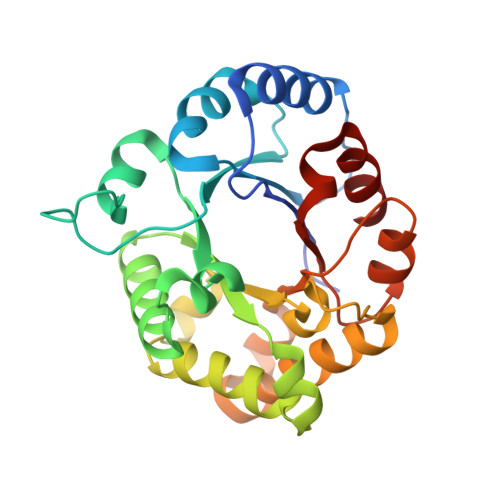The Role of Asn11 in Catalysis by Triosephosphate Isomerase.
Hegazy, R., Cordara, G., Wierenga, R.K., Richard, J.P.(2023) Biochemistry 62: 1794-1806
- PubMed: 37162263
- DOI: https://doi.org/10.1021/acs.biochem.3c00133
- Primary Citation of Related Structures:
7QH0 - PubMed Abstract:
Four catalytic amino acids at triosephosphate isomerase (TIM) are highly conserved: N11, K13, H95, and E167. Asparagine 11 is the last of these to be characterized in mutagenesis studies. The ND2 side chain atom of N11 is hydrogen bonded to the O-1 hydroxyl of enzyme-bound dihydroxyacetone phosphate (DHAP), and it sits in an extended chain of hydrogen-bonded side chains that includes T75' from the second subunit. The N11A variants of wild-type TIM from Trypanosoma brucei brucei ( Tbb TIM) and Leishmania mexicana ( Lm TIM) undergo dissociation from the dimer to monomer under our assay conditions. Values of K as = 8 × 10 3 and 1 × 10 6 M -1 , respectively, were determined for the conversion of monomeric N11A Tbb TIM and Lm TIM into their homodimers. The N11A substitution at the variant of Lm TIM previously stabilized by the E65Q substitution gives the N11A/E65Q variant that is stable to dissociation under our assay conditions. The X-ray crystal structure of N11A/E65Q Lm TIM shows an active site that is essentially superimposable on that for wild-type Tbb TIM, which also has a glutamine at position 65. A comparison of the kinetic parameters for E65Q Lm TIM and N11A/E65Q Lm TIM-catalyzed reactions of ( R )-glyceraldehyde 3-phosphate (GAP) and (DHAP) shows that the N11A substitution results in a (13-14)-fold decrease in k cat / K m for substrate isomerization and a similar decrease in k cat for DHAP but only a 2-fold decrease in k cat for GAP.
Organizational Affiliation:
Department of Chemistry, University at Buffalo, SUNY, Buffalo, New York 14260-3000, United States.





















